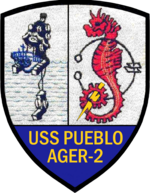USS Pueblo (AGER-2)

Pueblo in October 1967
|
|
| History | |
|---|---|
| Name: | Pueblo |
| Namesake: | Pueblo, Colorado and Pueblo County, Colorado |
| Builder: | Kewaunee Shipbuilding and Engineering |
| Laid down: | 1944 |
| Launched: | 16 April 1944 |
| Commissioned: | 7 April 1945 |
| In service: | 1945 |
| Reclassified: |
18 June 1966, AKL-44 13 May 1967, AGER-2 |
| Honors and awards: |
|
| Captured: | 23 January 1968 |
| Fate: | Captured by North Korea |
| Status: | Active, in nominal commission to prevent seizure, currently held by North Korea as a museum ship. |
| Badge: |  |
| General characteristics | |
| Class and type: |
|
| Type: | (As Built) Light Cargo Ship (As Converted) Intel-Gathering Vessel |
| Displacement: | 550 tons light, 895 tons full, 345 tons dead |
| Length: | 177 ft (54 m) |
| Beam: | 32 ft (9.8 m) |
| Draft: | 9 ft (2.7 m) |
| Propulsion: | Two 500hp GM Cleveland Division 6-278A 6-cyl V6 Diesel engines |
| Speed: | 12.7 knots (23.5 km/h; 14.6 mph) |
| Complement: | 6 officers, 70 men |
| Armament: | 2 × M2 Browning .50-caliber machine guns |
18 June 1966, AKL-44
USS Pueblo (AGER-2) is a Banner-class environmental research ship, attached to Navy intelligence as a spy ship, which was attacked and captured by North Korean forces on 23 January 1968, in what is known today as the "Pueblo incident" or alternatively, as the "Pueblo crisis".
The seizure of the U.S. Navy ship and its 83 crew members, one of whom was killed in the attack, came less than a week after President Lyndon B. Johnson's State of the Union address to the United States Congress, just a week before the start of the Tet Offensive in South Vietnam during the Vietnam War, and only three days after 31 men of North Korea's KPA Unit 12 had crossed the Korean Demilitarized Zone (DMZ) and killed 26 South Koreans in an attempt to attack the South Korean Blue House (executive mansion) in the capital Seoul. The taking of Pueblo and the abuse and torture of its crew during the subsequent 11-month prisoner drama became a major Cold War incident, raising tensions between the western democracies and the Union of Soviet Socialist Republics and People's Republic of China.
North Korea stated that Pueblo deliberately entered their territorial waters 7.6 nautical miles (14 km) away from Ryo Island, and that the logbook shows that they intruded several times. However, the United States maintains that the vessel was in international waters at the time of the incident and that any purported evidence supplied by North Korea to support its statements was fabricated.
...
Wikipedia
